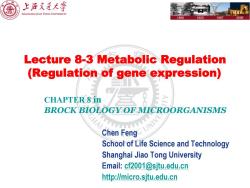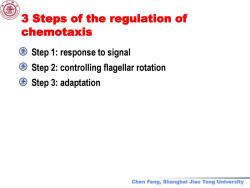上海交通大学:《微生物学 Microbiology》课程教学资源(双语课件)Lecture 8.3 Metabolic Regulation(Differences between prokaryotes and eukaryotes in gene expression、RNA-Based Regulation)

上浒充通大¥ SHANGHAI JIAO TONG UNIVERSITY 1896 1920 1987 2006 Lecture 8-3 Metabolic Regulation (Regulation of gene expression) CHAPTER 8 in BROCK BIOLOGYOFMICROORGANISMS UNI Chen Feng School of Life Science and Technology Shanghai Jiao Tong University Email:cf2001@sjtu.edu.cn http://micro.sjtu.edu.cn
1896 1920 1987 2006 Lecture 8-3 Metabolic Regulation (Regulation of gene expression) Chen Feng School of Life Science and Technology Shanghai Jiao Tong University Email: cf2001@sjtu.edu.cn http://micro.sjtu.edu.cn CHAPTER 8 in BROCK BIOLOGY OF MICROORGANISMS

8.10 Signal transduction and two-component regulatory system Signal transduction信号转导 >The external signal is first detected by a sensor and then transmitted in a changed form to the rest of the regulatory machinery. Two component regulatory systems.二元调控系统 >A specific Sensor kinase located in the cell membrane传感激 酶 >A Response regulator protein反应调节蛋白 Chen Feng,Shanghai Jiao Tong University
Chen Feng, Shanghai Jiao Tong University 8.10 Signal transduction and two-component regulatory system Signal transduction 信号转导 The external signal is first detected by a sensor and then transmitted in a changed form to the rest of the regulatory machinery. Two component regulatory systems二元调控系统 A specific Sensor kinase located in the cell membrane传感激 酶 A Response regulator protein反应调节蛋白

Mechanism of Signal Transduction Environmental signal a sensor kinase in the cell Sensor membrane phosphorylates kinase itself in response to an environmental signal. The phosphoryl group ATP ADP Cytoplasmic is then transferred to a membrane response regulator. The phosphorylated Response regulator response regulator serves as a repressor. Phosphatase activity RNA a phosphatase polymerase Transcription blocked DNA cycle the response Promoter Operator Structural genes regulator. e2的2 Pearon Eduon hg
Mechanism of Signal Transduction a sensor kinase in the cell membrane phosphorylates itself in response to an environmental signal. The phosphoryl group is then transferred to a response regulator. The phosphorylated response regulator serves as a repressor. a phosphatase cycle the response regulator

O TONG Mechanism:Phosphorylation and dephosphorylation of regulator proteins Environmental signal Phosphorylation determines whether Sensor a regulator protein can bind to dNA kinase or not..磷酸化决定调节蛋白是否结 Cytoplasmic 合DNA membrane Sensor kinase receive signal and Response regulator transfer the signal in the form of Phosphatase phosphorylation传感蛋白通过磷 activity RNA polymerase Transcription blocked DNA 酸化接受信号 Promoter Operator Structural genes Chen Feng,Shanghai Jiao Tong University
Chen Feng, Shanghai Jiao Tong University Mechanism: Phosphorylation and dephosphorylation of regulator proteins Phosphorylation determines whether a regulator protein can bind to DNA or not.磷酸化决定调节蛋白是否结 合DNA Sensor kinase receive signal and transfer the signal in the form of phosphorylation 传感蛋白通过磷 酸化接受信号

8.12 Signal Transduction:Mechanism of chemotaxis趋化性的机理:信号转导 Sensory proteins in the cell membrane细胞膜上有传 感蛋白 sense concentration changes of stimulus over time as cell moves.作用:通过时间变化来感应刺激物浓度变化. They are called methyl-accepting chemotaxis proteins (MCPs),or receptor-transducer proteins,or simply transducers.这些传感蛋白被称为甲基受体趋化蛋白 (MCP)或受体转导蛋白或转导蛋白. Chen Feng,Shanghai Jiao Tong University
Chen Feng, Shanghai Jiao Tong University 8.12 Signal Transduction: Mechanism of chemotaxis 趋化性的机理:信号转导 Sensory proteins in the cell membrane细胞膜上有传 感蛋白 • sense concentration changes of stimulus over time as cell moves.作用: 通过时间变化来感应刺激物浓度变化. • They are called methyl-accepting chemotaxis proteins (MCPs), or receptor-transducer proteins, or simply transducers. 这些传感蛋白被称为甲基受体趋化蛋白 (MCP) 或受体转导蛋白或转导蛋白

3 Steps of the regulation of chemotaxis Step 1:response to signal Step 2:controlling flagellar rotation ©Step3:adaptation Chen Feng,Shanghai Jiao Tong University
Chen Feng, Shanghai Jiao Tong University 3 Steps of the regulation of chemotaxis Step 1: response to signal Step 2: controlling flagellar rotation Step 3: adaptation

Bacterial chemotaxis: Attractants sensor kinase Transducer(MCP) CheA Chew ATP CheW CheA CheA- +CH3 Flagellar motor CheR CheB-P CheB CheY CheY-P CheZ response regulators -CH3 CheB and CheY Cytoplasmic membrane Cell wall step1,response to signal趋化过程第一步:对信号作出反应 Chen Feng,Shanghai Jiao Tong University
Chen Feng, Shanghai Jiao Tong University step 1, response to signal 趋化过程第一步: 对信号作出反应 response regulators CheB and CheY sensor kinase CheA Bacterial chemotaxis:

Attractants sensor kinase Transducer(MCP) CheA Chew ATP CheW CheA CheA- +CH3 Flagellar motor CheR CheB-P CheB CheY CheY-P CheZ response regulators -CH3 CheB and CheY Cytoplasmic membrane Cell wall The transducer(MCP)forms a complex with sensor kinase CheA and the coupling protein CheW.This combination results in autophosphorylation of CheA to CheA-P. Attractants decrease the rate of autophosphorylation,whereas repellents increase this rate.MCP与CheA和Chew结合,导致CheA自磷酸化。引诱物降低自磷酸化速率 Chen Feng,Shanghai Jiao Tong University
Chen Feng, Shanghai Jiao Tong University The transducer (MCP) forms a complex with sensor kinase CheA and the coupling protein CheW. This combination results in autophosphorylation of CheA to CheA-P. Attractants decrease the rate of autophosphorylation, whereas repellents increase this rate.MCP与CheA和Chew结合, 导致CheA自磷酸化。引诱物降低自磷酸化速率 response regulators CheB and CheY sensor kinase CheA

Attractants sensor kinase Transducer(MCP) CheA Chew ATP CheW CheA CheA- P +CH3 Flagellar motor CheR CheB-P CheB CheY CheY-P CheZ response regulators -CH3 CheB and CheY Cytoplasmic membrane Cell wall CheA-P can then phosphorylate the response regulators CheB and CheY.Phosphorylated CheY (CheY-P)interacts directly with the flagellar motor switch. Chen Feng,Shanghai Jiao Tong University
Chen Feng, Shanghai Jiao Tong University CheA-P can then phosphorylate the response regulators CheB and CheY. Phosphorylated CheY (CheY-P) interacts directly with the flagellar motor switch. response regulators CheB and CheY sensor kinase CheA

Step 2:Controlling the Rotation of flagellum Attractants Transducer(MCP) ATP CheW CheA CheA +CH3 -Flagellar motor heB CheB CheY CheY-P CheZ CH3 Cytoplasmic membrane Cell wall 国 CheY-P binding to motor switch:clockwise rotation-tumble CheY-P结合于马达开关则鞭毛 顺时针转动(翻滚): No CheY-P binding:counterclockwise rotation-smooth swimming 无ChY-P时则鞭毛逆时针 转动向前游): 国 CheZ dephosphorylates CheY-P CheZ对CheY-P脱磷酸化
Step 2: Controlling the Rotation of flagellum CheY-P binding to motor switch: clockwise rotation-tumble CheY-P结合于马达开关则鞭毛 顺时针转动(翻滚); No CheY-P binding: counterclockwise rotation-smooth swimming 无ChY-P时则鞭毛逆时针 转动(向前游); CheZ dephosphorylates CheY-P CheZ对CheY-P脱磷酸化
按次数下载不扣除下载券;
注册用户24小时内重复下载只扣除一次;
顺序:VIP每日次数-->可用次数-->下载券;
- 上海交通大学:《微生物学 Microbiology》课程教学资源(双语课件)Lecture 8.2 Metabolic Regulation(Regulation of Gene Expression).pdf
- 上海交通大学:《微生物学 Microbiology》课程教学资源(双语课件)Lecture 8.1 Regulation of Gene Expression(Overview、Regulation of Enzyme Activity、Transcriptional level regulation).pdf
- 上海交通大学:《微生物学 Microbiology》课程教学资源(双语课件)Lecture 7.3 Essentials of Molecular Biology(mRNA Transcription、PROTEIN SYNTHESIS).pdf
- 上海交通大学:《微生物学 Microbiology》课程教学资源(双语课件)Lecture 7.1 Essentials of Molecular Biology(Genes and Gene Experession、DNA STRUCTURE).pdf
- 上海交通大学:《微生物学 Microbiology》课程教学资源(双语课件)Lecture 6.2 Microbial Growth Control in vitro and in vivo(ANTIMICROBIAL AGENTS USED IN VIVO 体内使用的抗微生物制剂、ANTIMICROBIAL DRUG RESISTANCE AND DRUG DISCOVERY 抗药性与新药研制).pdf
- 上海交通大学:《微生物学 Microbiology》课程教学资源(双语课件)Lecture 6.1 Microbial Growth Control in vitro and in vivo(Physical Antimicrobial Control、Chemical Antimicrobial Control).pdf
- 上海交通大学:《微生物学 Microbiology》课程教学资源(双语课件)Lecture 5.3 Microbial Growth(Environmental Effects on Microbial Growth).pdf
- 上海交通大学:《微生物学 Microbiology》课程教学资源(双语课件)Lecture 5.2 Microbial Growth(Measuring Microbial Growth 微生物生长的测定(计数)).pdf
- 上海交通大学:《微生物学 Microbiology》课程教学资源(双语课件)Lecture 5.1 Microbial Growth(Bacterial Cell Division、Growth of Bacterial Populations 细菌群体生长).pdf
- 上海交通大学:《微生物学 Microbiology》课程教学资源(双语课件)Lecture 4 Nutrition, Laboratory Culture and Metabolism of Microorganisms(2/2).pdf
- 上海交通大学:《微生物学 Microbiology》课程教学资源(双语课件)Lecture 4 Nutrition, Laboratory Culture and Metabolism of Microorganisms(1/2).pdf
- 上海交通大学:《微生物学 Microbiology》课程教学资源(双语课件)Lecture 3 Microbial Cell Biology(3.4)Surface structures and inclusions of prokaryotes.pdf
- 上海交通大学:《微生物学 Microbiology》课程教学资源(双语课件)Lecture 3 Microbial Cell Biology(3.3)Cell Wall of Prokaryotes:Peptidoglycan and Related Molecules.pdf
- 上海交通大学:《微生物学 Microbiology》课程教学资源(双语课件)Lecture 3 Microbial Cell Biology(3.2)Cell Membrances and Cell Walls.pdf
- 上海交通大学:《微生物学 Microbiology》课程教学资源(双语课件)Lecture 3 Microbial Cell Biology(3.1)Microscopy and cell morphology.pdf
- 上海交通大学:《微生物学 Microbiology》课程教学资源(双语课件)Lecture 2 An Overview of Microbial Life.pdf
- 上海交通大学:《微生物学 Microbiology》课程教学资源(双语课件)Lecture 18.2 Diversity of Eucaryotic Microbe(Eukaryotic Microorganisms)Fungi 真菌、Algae 藻类.pdf
- 上海交通大学:《微生物学 Microbiology》课程教学资源(双语课件)Lecture 18.1 Diversity of Eucaryotic Microbe(Eukaryotic Microorganisms)Eukaryotic cell structure function and genetics、Eukaryotic Microbial Diversity.pdf
- 上海交通大学:《微生物学 Microbiology》课程教学资源(双语课件)Lecture 17.2 Diversity of Bacteria(Other Bacteria).pdf
- 上海交通大学:《微生物学 Microbiology》课程教学资源(双语课件)Lecture 17.1 Diversity of Bacteria(The Proteobacteria)The Phylogeny of Bacteria、Phototrophic, Chemolithotrophic, and Methanotrophic Proteobacteria、Aerobic and Facultatively Aerobic、Delta-and Epsilonproteobacteria.pdf
- 上海交通大学:《微生物学 Microbiology》课程教学资源(双语课件)Lecture 9.1 Essentials of Virology(VIRUS AND VIRION).pdf
- 上海交通大学:《微生物学 Microbiology》课程教学资源(双语课件)Lecture 9.2 Essentials of Virology(Viral Replication 病毒复制、Viral Diversity).pdf
- 上海交通大学:《微生物学 Microbiology》课程教学资源(双语课件)Lecture 9.3 Essentials of Virology and Test(Overview of Animal Viruses、Retroviruses).pdf
- 上海交通大学:《微生物学 Microbiology》课程教学资源_常见微生物名称中英文索引.pdf
- 上海交通大学:《微生物学 Microbiology》课程教学资源(中文课件)第1章 绪论(主讲:陈峰).pdf
- 上海交通大学:《微生物学 Microbiology》课程教学资源(中文课件)第10章 微生物与基因工程.pdf
- 上海交通大学:《微生物学 Microbiology》课程教学资源(中文课件)第11章 微生物生态.pdf
- 上海交通大学:《微生物学 Microbiology》课程教学资源(中文课件)第2章 纯培养和显微技术.pdf
- 上海交通大学:《微生物学 Microbiology》课程教学资源(中文课件)第3章 微生物细胞的结构与功能.pdf
- 上海交通大学:《微生物学 Microbiology》课程教学资源(中文课件)第4章 微生物的营养.pdf
- 上海交通大学:《微生物学 Microbiology》课程教学资源(中文课件)第5章 微生物的代谢.pdf
- 上海交通大学:《微生物学 Microbiology》课程教学资源(中文课件)第6章 微生物的生长繁殖及其控制.pdf
- 上海交通大学:《微生物学 Microbiology》课程教学资源(中文课件)第7章 病毒学概论.pdf
- 上海交通大学:《微生物学 Microbiology》课程教学资源(中文课件)第8章 微生物遗传.pdf
- 上海交通大学:《微生物学 Microbiology》课程教学资源(中文课件)第9章 微生物基因表达的调控.pdf
- 上海交通大学:《微生物的世界 Microbial World》通识教育课程教学资源(课件讲稿)第10章 微生物的生长繁殖及其控制.pdf
- 上海交通大学:《微生物的世界 Microbial World》通识教育课程教学资源(课件讲稿)第1章 绪论(陈峰).pdf
- 上海交通大学:《微生物的世界 Microbial World》通识教育课程教学资源(课件讲稿)第2章 微生物的多样性与特点.pdf
- 上海交通大学:《微生物的世界 Microbial World》通识教育课程教学资源(课件讲稿)第3章 生命的起源与演化.pdf
- 上海交通大学:《微生物的世界 Microbial World》通识教育课程教学资源(课件讲稿)第4章 泡菜坛里有乾坤——微生物的代谢.pdf
